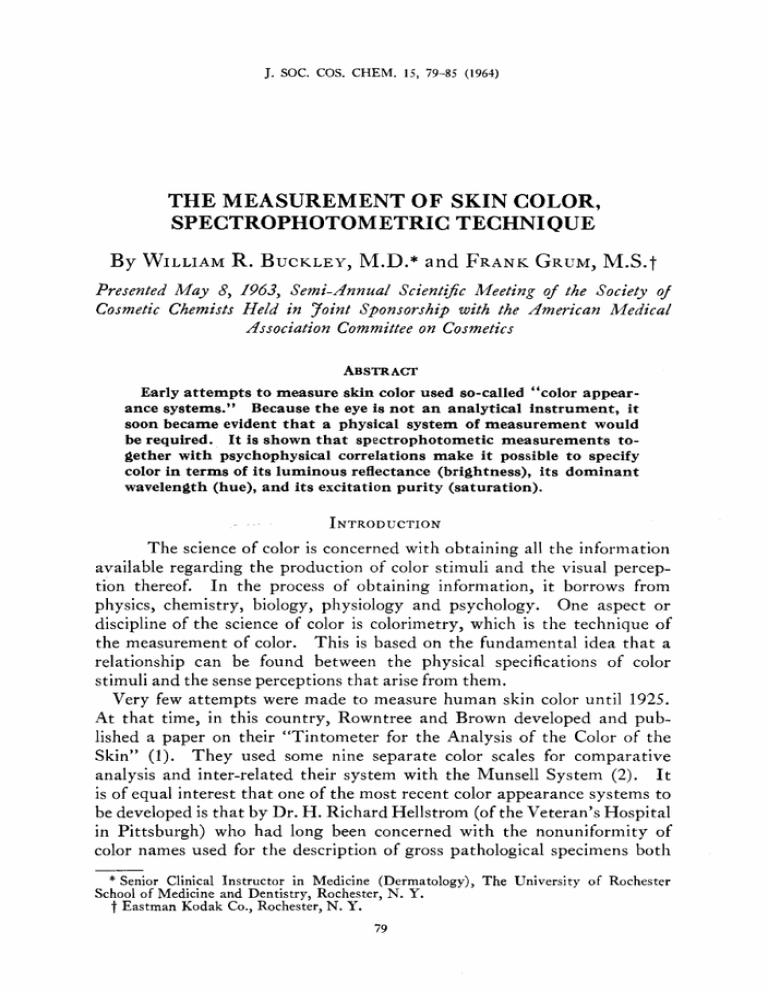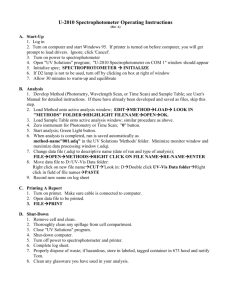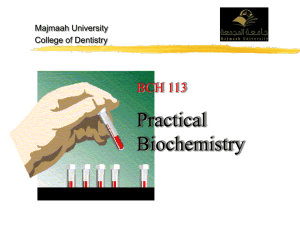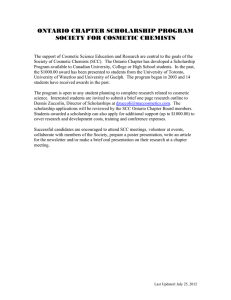the measurement of skin color, spectrophotometric technique
advertisement

J. soc. cos. CHEM. 15, 79-85 (1964) THE MEASUREMENT OF SKIN COLOR, SPECTROPHOTOMETRIC TECHNIQUE By WIL,4^M R. M.D.* and FR^NKGRur, M.S.t Presented May 8, 1963, Semi-AnnualScientificMeetingof the SocietyoJ CosmeticChemistsHeld in 5tointSponsorshipwith the American Medical Association Committee on Cosmetics ABSTRACT Early attempts to measure skin color used so-called "color appearance systems." Because the eye is not an analytical instrument, it soon became evident that a physical system of measurement would be required. It is shown that spectrophotometic measurements together with psychophysical correlations make it possible to specify color in terms of its luminous reflectance (brightness), its dominant wavelength (hue), and its excitation purity (saturation). INTRODUCTION The scienceof coloris concerned with obtainingall the information availableregardingthe productionof colorstimuli and the visual perception thereof. In the processof obtaining information, it borrowsfrom physics,chemistry,biology,physiologyand psychology. One aspector disciplineof the scienceof coloris colorimetry,which is the techniqueof the measurement of color. This is based on the fundamental idea that a relationshipcan be found betweenthe physical specificationsof color stimuliandthe senseperceptions that arisefrom them. Very few attempts were made to measurehuman skin color until 1925. At that time, in this country,Rowntreeand Brown developedand publisheda paperon their "Tintometerfor the Analysisof the Color of the Skin" (1). They used somenine separatecolor scalesfor comparative analysisand inter-relatedtheir systemwith the Munsell System (2). It is of equalinterestthat oneof the mostrecentcolorappearancesystemsto be developedis that by Dr. H. RichardHellstrom(of the Veteran'sHospital in Pittsburgh) who had long been concernedwith the nonuniformityof colornamesusedfor the descriptionof grosspathologicalspecimensboth * Senior Clinical Instructor in Medicine (Dermatology), The University of Rochester Schoolof Medicine and Dentistry, Rochester,N. ¾. t Eastman Kodak Co., Rochester,N. ¾. 79 80 JOURNAL OF THE SOCIETY OF COSMETIC CHEMISTS in operatingand dissectingroomsand in the generalmedicalliterature. This "Method of ColorDescriptionfor Use in GrossPathology,"an adaptation of The ISCC-NBS Method of DesignatingColors,(3) is expectedto be of somevalue if it is acceptedby pathologists. The principaldrawback to the use of sucha simplecolor chart is the preconceived notion of different observers of what each color should be called. Both of thesetechniques of measuringand specifyingskincoloror color of biologicalmaterialsare mentionedherebecausethey are fundamentally basedon a "colorappearance system." In this type of systemthe colors are selectedand arrangedwith respectto appearance. The relationships involvedarepsychological rather than physicalor psycho-physical. It is alsogenerallyagreedthat it is impossibleto representan equally spacedcolor system in three-dimensionalspace. In addition, the best arrangementby psychological attributesis not the bestfor obtainingequal spacing. The productionof physicallyreproduciblestandardsfor colors of the spaceis usuallyaccomplished by resortingto C.I.E. (4) tristimulus and reflectancevaluesfor samplecoloror colorantcombinations;however, suchcombinations do not give a seriesof colorsconformingto equalspacing by psychological attributesin three-dimensional space. The earliestattemptsto measureskin colorusinga spectrophotometer, at least in this country, were made by Sheard and Brown (5). Their work was publishedin 1926. A few years later this original work was expandedby Sheardand Brunsting,and publishedin 1929 in a seriesof three papers (6). Their work was excellentwhen it is realizedthat the spectrophotometer they usedwas crude, and the newertristimulusvalues were not evenagreedupon at that time. The final project putting spectrophotometry on a soundbasisin the measurementof skin colorwas that by Edwards and Duntley in 1939 (7). This work establishedmost of the skin colorants. Moreover, the Hardy Spectrophotometer, a really fine instrument,was utilized for the measurements. STATEMENT OF PROBLEM In this paper, an attempt will be to specifyhumanskin colorin terms of a definiteset of physicaloperations. This is not unusualwhen it is realizedthat any definitionof a quantity is only a statementof the proceduresby whichthe quantity is appraised. First of all, the reflectanceof the skin will dependon the following factors(8): (1) The surfacelayersof the epidermis, (2) The amountanddistributionof the pigments, MEASUREMENT OF SKIN COLOR 81 (3) The over-allturbidity of the skin (duechieflyto the melaningran. ulesand cellularconstituents),and (4) The fillingof thesubpapillary plexus. A second feature of the reflectance is the fact that a cross section of human skin, as observedfrom the surfacedownward,shouldbe considered as multilayered. As the incident flux within the spectrophotometer strikeseachlayer: A portionis reflected;a portionis scattered;a portion is absorbed;and a portion is transmittedon downwardto the next layer. The samephenomenaoccur at that layer, and so forth until the energy of the incidentbeamis dissipated. The total spectralreflectancemeasured by the spectrophotometer contains,therefore,the absorptionbandsdue to the variouspigmentswithin the layersof the skin. RESULTS AND DISCUSSION' The followingmeasurements of total spectralreflectanceweremadewith the General Electric Spectrophotometer:Figure 1 showsan averagereflectancecurve of the skin taken from 10 different white subjectsof both sexesand with various complexions. The skin area measuredwas the malar regionof the left cheek.. The general characteristicof the curve is its generalslopedownwardfrom right to left. In other words,skin reflectsmore spectralred and yellow but lessviolet, blue and green. This gradualslopecan be shownto be due to the pigmentmelanin. There is a strongabsorptionbandat approximately415 mtadue to the hemoglobins --chiefly oxyhemoglobin.This dip is somewhatless than might be expected becauseof marked scatter in this regiondue to melanin granules and the other cellularconstituents. Proceedingagain to the right on the curve,there is a slopethat extendsfrom 465 to about510 m**. This slope has a maximal absorptionband due to the carotenoidsat approximately 480 mu. Continuingstill further to the right on the curve, there are two dipsor absorptionbandslocatedat 542 and 575 mu, due to oxyhemoglobin. There is no recognizable absorptionbanddue to reducedhemoglobinnoted in the normal reflectance curve. Spectralreflectancecurvesare, in the beginning,rather confusingwhen they are studiedby thosenot acquaintedwith them. However, they providevastly moreinformationthan can be obtainedby visualexamination of the color of the object in question. Moreover, the information that can be obtainedfrom the curve is essentialin the solvingof many colorproblems. How are spectrophotometric data used to developa color specification for human skin? It has been known for well over a hundred years that very nearly all colorsencounteredin nature can be matched by merely adjustingthe intensities of the red,greenandbluecomponents of a mixture of coloredlight. Sucha mixturemay bereadilyproducedby threelanterns 82 JOURNAL OF THE SOCIETY OF COSMETIC CHEMISTS arrangedto project three partially overlappingspots--a red, a greenand a blue on a white screen. Where the greenand red overlap,the mixture appearsyellow. Where the blue and red overlap, the mixture appears magenta. Where the blue and greenoverlap,the mixture appearscyan. Whereall threebeamsor spotsoverlap,themixtureappears white. 60 i i _.m30 o• 2o I VioletBlue GreenYellow Red 400 500 600 700 Wovelength (mp.) Figure 1.--Total spectralreflectancecurve--averagewhite skin, Thus the data of color vision on which color measurement must be basedare obtainedby systematicexperimentsin which many colorsare matchedvisually. The intensitiesof the red (-•), green(•), and blue (2) components necessaryto match equal amountsof energyat eachwavelengthof the spectrumcan be plotted as curves,shownin Fig. 2. These are called colormixture functions. They have beenstandardizedto very great accuracyby the InternationalCommission on Illuminationand by the American Standards Association. Using I.C.I. Illuminant C (whoseenergydistributionover the visible spectrumis known) as the representativesourceof averagedaylight,it is possible to obtainthe spectraldistributionof the light reflectedfromthe skin (9). This is accomplished by multiplyingper cent reflectancetimes energyat eachwavelengthof the spectrum. The curve so obtainedcan then be multiplied,wavelengthby wavelength,by eachof the threecolor mixture functionsto obtain the fundamentalspecificationsof the color of the skin (10). From the averagereflectance curveshownin Fig. 1, the tristimulus values would be: X = 38.0 ¾ = 29.2 Z = 32.9 MEASUREMENT OF SKIN COLOR 83 2.½ Color Mixture Functions 1o0 0.0 •i Wavelength in m• 6o• 700 Figure 2.--CIE tristimulusvalues•, 3, and • for the spectrumcolors. Becausethe • functionchosenas one of the primariescorresponds exactlyto theso-called visibilityfunctionfor a normaleye,the relativebrightnessof the skinsampleis givenas29.2per cent,whichwouldbeequivalent to its Y function. 84 JOURNAL OF THE SOCIETY OF COSMETIC CHEMISTS .BO .75 .70 .6.5 .5.3 .StJ .4.3 .40 .33 30 2.; .05 o .03 .10 .15 .20 .25 .30 .35 .l/J .t.; ..;n .5.; .60 .65 .70 .75 Figure3.--Chromaticity diagramfromaveragetotalspectralreflectance curve. Thequalityof theskincolorisobtained by defining threenewquantities, the trichromaticcoefficients. In thisparticularcase: x = 0.3786 y = 0.3374 z = 0.2840 Plottingthe x andy trichromatic coefficients on a "ChromaticityDia- MEASUREMENT OF SKIN COLOR 85 gram," (Fig. 3) it can be determinedthat the averagereflectanceof 10 samplesof white skin as shownin Fig. 1 has a dominantwavelengthof 593 mtz (yellowishhue) and an excitationpurity of 24.0 per cent. Thus you have a completecolor specificationfrom the spectrophotometric findings. Beforeclosing,it shouldbe pointedout that the valuesas given do not include any contribution from the fluorescenceof the skin. Under ordinary circumstances this presentsno problem. However, under certain circumstances, it may be necessaryor desirableto measureskin fluorescence and its effect on over-all skin color. Grum and Wightman (11) have presenteda paper on the techniqueof measuringthis fluorescence by modifyinga spectrophotometer in such a way that it will recordfrom the sampleat eachwavelengththe "complete radiation." Completeor total radiationis the sumof the fluorescence and reflectance from the sample. SUMMARY Colorimetryis the techniquefor measuringthe colorof objectsor surfaces. The earliestattemptsto measureskin colorwere by using"color appearancesystems." Becausethe eye is not an analyticalinstrument,it soonbecameevident that a physicalsystemof measurementwould be required. The spectrophotometer providedthis approach. Throughpsychophysicalcorrelations,it becamepossibleto use spectrophotometric data to specifycolorin terms of its luminousreflectance(brightness),its dominantwavelength(hue),andits excitationpurity (saturation). Special procedures are requiredwhenthe effectof fluorescence is to be includedin measuringskin color. (ReceivedJune 10, 1963) REFERENCES (1) L. G. Rowntree and G. E. Brown, `4m. •. Med. Sci., 170, 341 (1925). (2) A. Munsell,.4 ColorNotation,6th Edition, MunsellColorCo., Baltimore,Md., 1923. (3) NationalBureauof Standards, ISCC-NBSMethodof DesignatingColors,NBS Circular 553, GovernmentPrinting Office,WashingtonD.C., 1955. (4) Commission Internationalede l'Eclairage,Proceedings of theEighthSession, Cambridge, England,1932,pp. 19-29. (5) C. Sheardand G. E. Brown,.4rch.Intern. Med., 38, 816 (1962). (6) C. SheardandL. A. Brunsting,•. ClinInvest.,7, 559 (1929); Idem., •e.Clin.Invest.,7, 575 (1929); Idem., •. Clin. Invest.,7, 593 (1929). (7) E. A. Edwardsand S. Q. Duntley, .4m. •..4nat., 65, 1 (1939). (8) W. R. Buckleyand F. Grum, .4.M..4..4rch. Dermatol.,83, 249 (1961). (9) A. Hardy, et al., Handbookof Colorimetry, Preparedby the Staff of the ColorMeasurement Laboratory of Massachusetts Institute of Technology,The TechnologyPress, Cambridge, 1936. (10) D. L. MacAdam, T.4PPI, 38, 78 (1955). (11) F. Grum andT. Wightman,Ibid., 43, 400 (1960). 86 JOURNAL OF THE SOCIETY OF COSMETIC CHEMISTS NOTICE S.C.C. TO MEMBERS Many membersof the Societyhave requestedthat a completerosterof their fellow-members be madeavailable. Such a membershiplist is now in preparationand, it is hoped,will be publishedin oneof the 1964issuesof the Journal. To be sure your own listing will be accurate,pleaseadvise the New York office,as soonas possible,of any changes in your address. Pleasesendthis informationto: Society of Cosmetic Chemists Mrs. Eunice Thomas Miner, Administrative Assistant 2 East 63rd Street New York 21, New York





